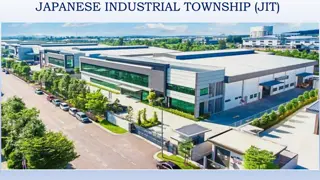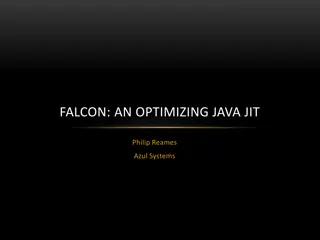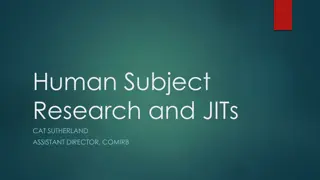Introduction to JIT Management Philosophy
JIT (Just In Time) is a manufacturing philosophy focused on producing only what is needed when it is needed, resulting in a highly coordinated processing system. Evolving in Japan post World War II, particularly at Toyota Motor Company under Taiichi Ohno, JIT emphasizes achieving high production volume with minimal inventories. It aims to eliminate waste, achieve a balanced flow of materials, and make the production system flexible. JIT involves pulling raw materials, parts, and sub-assemblies through the manufacturing process as needed, ultimately streamlining production and reducing disruptions caused by quality issues, schedule changes, and late deliveries.
Download Presentation

Please find below an Image/Link to download the presentation.
The content on the website is provided AS IS for your information and personal use only. It may not be sold, licensed, or shared on other websites without obtaining consent from the author.If you encounter any issues during the download, it is possible that the publisher has removed the file from their server.
You are allowed to download the files provided on this website for personal or commercial use, subject to the condition that they are used lawfully. All files are the property of their respective owners.
The content on the website is provided AS IS for your information and personal use only. It may not be sold, licensed, or shared on other websites without obtaining consent from the author.
E N D
Presentation Transcript
What Is JIT Management philosophy (produce only what is needed when it is needed) A highly coordinated processing system in which goods move through the system, and services are performed, just as they are needed Represents Pull type system
History of JIT Manufacturing Evolved in Japan after World War II, as a result of their diminishing market share in the auto industry. Toyota Motor Company- Birthplace of the JIT Philosophy Under Taiichi Ohno. JIT is now on the rise in American Industries.
Definition JIT is a manufacturing philosophy involving an integrated set of procedures/activities designed to achieve a high volume of production using minimal inventories
More Introduction Raw materials, parts & sub assemblies are pulled through the manufacturing process when they are needed. Simply put, JIT is a philosophy of make what is needed when it is needed .
Goal of JIT The ultimate goal of JIT is a balanced system. Achieves a smooth, rapid flow of materials through the system Eliminate disruptions Make system flexible Eliminate waste, especially excess inventory
Summary of JIT Goals and Building Blocks Ultimate Goal A balanced rapid flow Supporting Goals Eliminate disruptions Make the system flexible Eliminate waste Building Blocks Product Design Process Design Personnel Elements Manufactur- ing Planning
Big vs. Little JIT Big JIT broad focus Vendor relations Human relations Technology management Materials and inventory management Little JIT narrow focus Scheduling materials Scheduling services of production
What JIT Does Eliminates waste Achieves streamlined production Eliminate disruptions in production caused by poor quality, schedule changes, late deliveries. Makes the manufacturing delivery system flexible by allowing it to handle a variety of products and changes in the level of output Reduces setup and delivery times
Eight Wastes THE EIGHT TYPES OF WASTE OR MUDA Waste Definition 1. Overproduction Manufacturing an item before it is needed. 2. Inappropriate Processing Using expensive high precision equipment when simpler machines would suffice. 3. Waiting Wasteful time incurred when product is not being moved or processed. 4. Transportation Excessive movement and material handling of product between processes. 5. Motion Unnecessary effort related to the ergonomics of bending, stretching, reaching, lifting, and walking. 6. Inventory Excess inventory hides problems on the shop floor, consumes space, increases lead times, and inhibits communication. 7. Defects Quality defects result in rework and scrap, and add wasteful costs to the system in the form of lost capacity, rescheduling effort, increased inspection, and loss of customer good will. 8. Underutilization of Employees Failure of the firm to learn from and capitalize on its employees knowledge and creativity impedes long term efforts to eliminate waste.
Sources of Waste Overproduction Waiting time Unnecessary transportation Processing waste Inefficient work methods Product defects
Strategies For Minimizing Waste By Using JIT Manufacturing in smaller lot sizes reduces excess inventory Reducing inventory levels allows the problems to be uncovered thus creating opportunities for manufacturing process improvement
Principles Of JIT Manufacturing Total Quality Management Production Management Supplier Management Inventory Management Human Resource Management
1st Principle Of JIT Total Quality Management
Total Quality Management Seek long-term commitment to quality efforts with continuous improvement Quality must be a higher priority than cost Minimizing waste
Total Quality Management Eliminate Quality Inspectors Quality is everyone s responsibility Do it right the first time
2nd Principle Of JIT Production Management
Production Management Pull System vs. Push System Pull = Made to order Push = Made for inventory Flexibility of the system Design For Testability In the process Poka-Yoke= Mistake-proofing Throughout entire process
Production Management Reduced lot sizes= Shorter cycle times Eliminate disruptions in the process Standardized Parts/ Simplicity
Production Management Communication Techniques Completion of task-Kanban Problem- Siren/light Stopping the process if something goes wrong =Jidoka Preventive Maintenance
3rd Principle Of JIT Supplier Management
Supplier Management Establish Long Term Relationships with few suppliers. Delivery of Parts = 100% Defect Free Where they are needed When they are needed The exact quantity Work Together
Supplier Management Elimination inspection of parts Communicate problems to suppliers in a positive manner.
4th Principle Of JIT Inventory Management
Inventory Management Eliminate Safety Stock = Zero Inventory JIT is not an inventory control system Reduction in inventory opens up space
Inventory hides problems in a process. Water Level = Inventory Rocks = Problems in the system Boat = Company Operations
5th Principle Of JIT Human Resource Management
Human Resource Management Company-wide Involvement Motivation for continuous improvement Problem Solving High Employee Interaction Build Pride In Workmanship
Human Resource Management Self-Inspection of work Diversified Employees Absenteeism To eliminate boredom in process Management Support and Empowerment of workforce
JIT Manufacturing Building Blocks Product design Process design Personnel/organizational elements Manufacturing planning and control
1. Product Design Standard parts Design Simplification Highly capable production systems Concurrent engineering
2. Process Design Small lot sizes Setup time reduction Limited work in process Quality improvement Production flexibility Little inventory storage
Benefits of Small Lot Sizes Reduces inventory Less rework Less storage space Problems are more apparent Increases product flexibility Easier to balance operations
Quality Improvement Autonomation Automatic detection of defects during production Jidoka Japanese term for autonomation
Production Flexibility Reduce downtime by reducing changeover time Use preventive maintenance to reduce breakdowns Cross-train workers to help clear bottlenecks Use many small units of capacity Reserve capacity for important customers
3. Personnel/Organizational Elements Workers as assets Cross-trained workers Continuous improvement Leadership
4. Manufacturing Planning and Control Pull systems Visual systems (kanban) Close vendor relationships Reduced transaction processing (delays in delievery) Preventive maintenance
Evaluation and selection of vendor (suppliers) network to develop a tiered supplier network reducing the number of primary suppliers.
Transitioning to a Successful JIT System Get top management commitment Decide which parts need most effort Obtain support of workers Start by trying to reduce setup times Gradually convert operations Convert suppliers to JIT Prepare for obstacles
Obstacles to Conversion Management may not be committed Workers/management may not be cooperative Suppliers may resist
Comparison of JIT and Traditional Factor Traditional JIT Much to offset forecast errors, late deliveries Large Minimal necessary to operate Inventory Small Deliveries Large Small Lot sizes Setup; runs Few, long runs Many, short runs Long-term relationships are unusual Necessary to do the work Partners Vendors Assets Workers
Comparison Of JIT & MRP JIT Repetitive production Minimal shop floor control Simpler Relies on visual or audible signals to trigger production and inventory (e.g. auto carpets) Lower inventories related to need at the time MRP Lot size or batch production Extensive shop floor control More complex Relies on computer system to trigger production and order inventory Inventories related to batch or lot sizes
JIT in Services The basic goal of the demand flow technology in the service organization is to provide optimum response to the customer with the highest quality service and lowest possible cost.
JIT Benefits Reduced Inventory Improved quality Lower costs Reduced space requirements Shorter lead-time Increased productivity Greater flexibility Improved vendor relations
JIT Benefits (contd.) Simplified scheduling & control Increased capacity Better utilization of personnel More product variety Increased equipment utilization Reduced paperwork Valid production priorities Work force participation
JIT Not For Everyone JIT concepts work best when goods can be produced in response to consumer demand (e.g. automobiles, etc.) JIT is less effective for the production of standardized consumer goods (e.g. basic clothing, food, soft drinks, toasters, etc.) There are cases where JIT concepts apply to sub-processes of a make to stock environment. (e.g. computers etc.)
References Cammaranano, J. Lessons to be Learned: JIT. Atlanta, Georgia: Engineering and Management Press, 1997. Dear, A. Working toward JIT: Management Technology. London: Derek Doyle and Associates, 1988. Fisher, D. The JIT Self Test: Success Through Assesment and Implementation. Chicago, IL: Irwin Inc., 1995. Hernandez, A. JIT Quality: A Practical Approach. Englewood Cliffs, NJ: Prentice-Hall, 1993. Hutchins, D. Just-In-Time: Inventory Control. Brookfield, VT: Gower Publishing, 1988. O Grady, P.J. Putting the JIT Philosophy Into Practice. New York, NY: Nichols Publishing, 1988. Reinfeld, N.V. Handbook of Production and Inventory Control. Englewood Cliffs, NJ: Prentice-Hall, 1987. Schneiderjans, M.J. Advanced Topics In JIT Management: JIT Systems. Westport, CT: Greenwood Publishing Group, 1999. Taver, R.W. Manufacturing Solutions for Consistent Quality and Reliability: The 9 Step Problem Solving Process. New York, NY: AMACON, 1995. Wesner, J.W., Hiatt, J.M., and Trimble, D.C. Winning with Quality: Applying Quality Principles in Product Development. Reading, MASS: Addison- Wesley Publishing Co., 1995.























